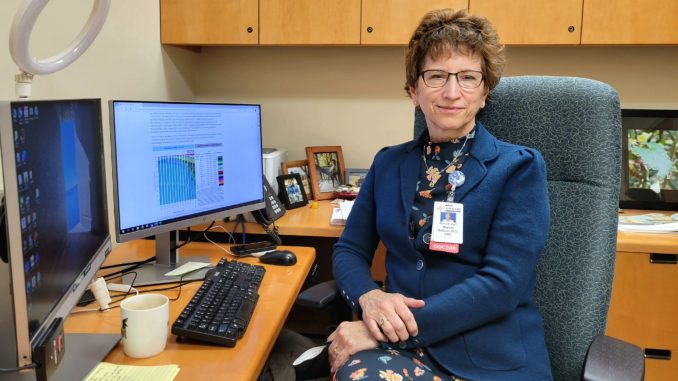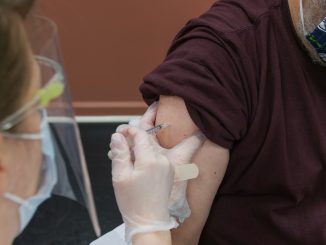
Dr. Marcia Nelson remembers her concerns last holiday season. COVID-19 took another upswing; from averaging 30 new cases a day in mid-November of 2021, Butte County doubled that rate during Christmas week and hit 300 a day in mid-January. There would be 64 deaths reported by County Public Health across the two months following Christmas.
Heading into Thanksgiving 2022, COVID isn’t as prevalent nor as deadly. The county average is currently five new cases a day. The most recent death locally came a month ago, Oct. 16.
“COVID is part of the fabric of how we do health care now,” said Nelson, chief medical officer at Enloe Medical Center. “We always have about five to 10 patients with COVID in the hospital; we sometimes have a person on a ventilator because of COVID. We’re not testing every patient who comes into the hospital for COVID—these are patients who come in with symptoms that suggest COVID. That really is a better indicator of the impact of COVID on our community.
“Last year, we were just coming off of the delta [variant] surge and didn’t really have omicron on our radar,” she recalled. “We were all anxious last year at this time because all these respiratory illnesses tend to get worse when people are gathering close together.
With two of those illnesses—influenza and especially respiratory syncytial virus (RSV)—hitting the North State earlier than normal this year, Nelson still has some concerns as colder weather brings us closer together. RSV in particular has stretched medical services, forcing Enloe to transfer patients beyond the usual destinations of Sacramento and the Bay Area—which are also impacted—to hospitals in Reno.
“I still share that mild apprehension about the holiday season coming up,” Nelson added.
Another pandemic pivot
“As of right now, the plan is to end the state emergency at the end of February, and so it seems like things are really settling down,” County Public Health Director Danette York said. “I always want to add the caveat that COVID is still here…. People are still getting it; luckily, most of them don’t get sick enough that they need to be hospitalized, but it does make people sick to where they miss work.
“RSV is the serious concern right now because it impacts very young children,” she added, “and a lot of times parents may think that their baby or young child has a cold and they wait it out, thinking it will pass. If they’re really sick, and they’re really having a hard time breathing, they need care, because it can be really dangerous.”
Last week, the California Department of Public Health (CDPH) sent an updated advisory to healthcare facilities in the state warning that “[a]n early wave of RSV activity and circulation of other respiratory viruses has led to increased hospitalizations among children and has contributed to stresses in the pediatric healthcare delivery system in California and across the US.”
Nelson, who also sees patients in family practice in Chico, noted that RSV typically peaks in January—yet Enloe has had to expand its pediatric ward from five beds to 12, and the disease is afflicting older children, even some adults.
“We’re in the midst of a spike several months earlier than the usual spike,” she said. “RSV is having a bigger impact on the community … and we’re starting to see some flu. We’re not in a flu surge right now, but [including COVID] we have three serious respiratory viruses in our community, and we’re just starting our winter season.
“As I think about how to get my arms around all of this, I think the most important thing to do is to do what we can. There are effective vaccines for COVID for people 6 months and older. There are effective vaccines for influenza for people 6 months and older. We don’t have vaccines for RSV, but if we could really temper down COVID and influenza so we don’t have three viruses peaking at the same time, then we will be a much healthier community for it.”
York agrees. She continues to emphasize preventative measures, including face coverings and social distancing in public group settings, noting that “many of the same precautions for COVID can protect against RSV and flu.” Nelson, along with stressing vaccination, also spoke to the importance of COVID tests before and after family gatherings with elderly, immunocompromized guests.
“Flu and RSV have always been here,” York said, “but COVID sucked the oxygen out of everything. It’s interesting, when monkeypox was going around [at its widest this summer], many of the public really got alarmed: ‘What is this? Is it another pandemic?’ Monkeypox, and RSV and flu, they’ve been around for a long time—and so have the treatments and/or vaccines.
“But many people didn’t pay that much attention to it unless it affected them—until COVID. When COVID came along, the general population really learned what we in public health really do, and so now everything kind of hits their radar. ‘Is this the next thing we should be concerned about?’ Nine times out of 10, it’s been around for a while and we’ll just continue what we’ve been doing with our health care provider partners.”
Respiratory illness resources:
Protect children from RSV:
https://www.cdc.gov/rsv/infographic.html
Butte County flu vaccine info:
https://www.buttecounty.net/ph/Programs/Communicable-Disease/Flu/GetVaccinated
Butte County COVID vaccine info:
https://www.buttecounty.net/ph/COVID19/vaccine



Be the first to comment